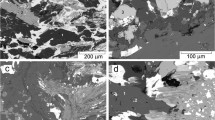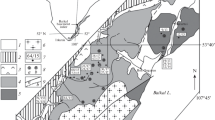Abstract
Eleven native minerals and intermetallic alloys were identified in rocks of the banded iron formation (BIF) in the Kola Peninsula: copper, silver, gold, electrum, auricupride, cuproauride, tetraauricupride, bismuth, sulfur, tellurium, and graphite. Graphite is a common mineral of sulfide-bearing BIF and gneiss. Sulfur occurs in supergene-altered sulfide-bearing BIFs together with Fe- and Ca-sulfates. Gold of low fineness (electrum) in association with electrum, acanthite, auricupride, volynskite, hessite, cervelleite, pavonite, petzite, and bismuth is related to the areas of hydrothermally altered skarnoids with greenalite, chamosite, aegirine, and Na-Ca amphibole. Redeposited gold of high fineness associated with auricupride, hessite, silver, electrum, kostovite, cuproauride, tetraauricupride, and sperrylite occurs in low-temperature zonal hydrothermal segregations hosted in aluminous gneiss and which formed under the effect of alkalized, highly siliceous solutions at the regressive stage of BIF metamorphism.
Similar content being viewed by others
References
A. V. Bazai and G. Yu. Ivanyuk, “Gold-Silver Mineralization of Skarnoids As Wall Rocks at the Olenegorsk Deposit,” in Proceedings of III Fersman Scientific Session Dedicated to the Fiftieth Anniversary of the Kola Division of Russian Mineralogy Society (K&M, Apatity, 2006), pp. 102–105 [in Russian].
I. G. Ganeev, “Structure and Properties of Hydrothermal Solutions. Migration Species of Mineral Substance,” Izv. Akad. Nauk SSSR, Ser. Geol., No. 3, 22–35 (1977).
N. N. Golikov, P. M. Goryainov, G. Yu. Ivanyuk, Ya. A. Pakhomovsky, and V. N. Yakovenchuk, “Gold-Bearing Iron Formation of the Olenegorsk Deposit (Kola Peninsula, Russia),” Geol. Rudn. Mestor. 41(2), 162–170 (1999) [Geol. Ore Deposits 41 (2), 144–151 (1999)].
P. M. Goryainov and G. Yu. Ivanyuk, Self-Organization of Mineral Systems (Geos, Moscow, 2001) [in Russian].
G. Yu. Ivanyuk and Ya. A. Pakhomovsky, “Mineral Assemblages of Au-Bearing Banded Iron Formation in the Kola Peninsula,” in Geology and Mineral Resources of Northeastern and Central Russia (Poligraf, Apatity, 1999), pp. 109–115 [in Russian].
G. Yu. Ivanyuk, A. V. Bazai, Ya. A. Pakhomovsky, V. N. Yakovenchuk, and P. M. Goryainov, “Low-Temperature Hydrothermal Veins in Banded Iron Ore Formation of the Kola Peninsula,” Zap. Vseross. Mineral. O-va 130(3), 16–28 (2001) [in Russian].
A. A. Kremenetsky and E. F. Mintser, “Universal Evolution of Gold Ore Systems: A Key Criterion of Regional Forecasting of Economic Ore Mineralization,” Otech. Geol., No. 5, 19–27 (1995).
V. N. Rumyantsev, “Role of Hydrolysis in Hydrothermal Mineral Deposition and Nature of Retrograde Solubility of Minerals in Water,” Zap. Vseross. Mineral. O-va 117(1), 29–36 (1988).
R. W. Tschernich, Zeolites of the World (Geoscience Press, Phoenix, 1992).
Author information
Authors and Affiliations
Corresponding author
Additional information
Original Russian Text © A.V. Bazai, G.Yu. Ivanyuk, Ya.A. Pakhomovsky, P.M. Goryainov, V.N. Yakovenchuk, 2009, published in Zapiski RMO (Proceedings of the Russian Mineralogical Society), 2009, Pt. CXXXVII, No. 5, pp. 34–47.
Rights and permissions
About this article
Cite this article
Bazai, A.V., Ivanyuk, G.Y., Pakhomovsky, Y.A. et al. Native elements in rocks of the banded iron formation, Kola Peninsula. Geol. Ore Deposits 51, 525–536 (2009). https://doi.org/10.1134/S1075701509070022
Received:
Published:
Issue Date:
DOI: https://doi.org/10.1134/S1075701509070022




